Pork Adobo is a Filipino comfort food classic! Tender pork belly braised in a savory, tangy sauce that's simple to prepare, and perfect for leftovers!
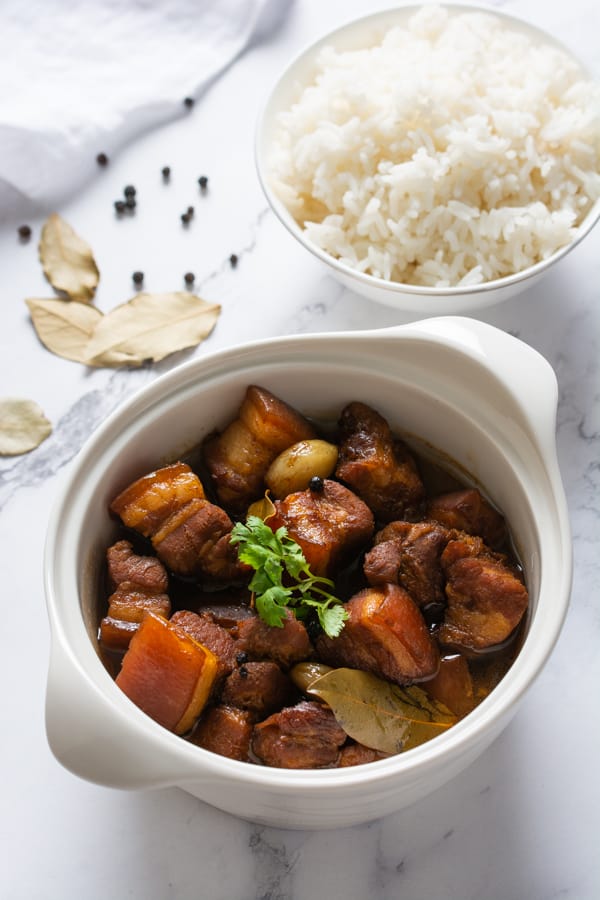
While Chicken Adobo is often considered the national dish of the Philippines (not to be confused with Mexican adobo), Pork Adobo is also a very popular Filipino dish and every bit as delicious.
This version of Pork Belly Adobo is a rich, comforting dish all about bold flavors with minimal effort.
Tender pork belly, slowly braised in a savory and tangy sauce - this dish never disappoints. The magic is in the Adobo sauce - a mixture of vinegar and soy sauce, combined with the deep flavors of garlic and the earthy notes of bay leaves.
Whether you're making it for a weeknight dinner or prepping ahead for the week, this dish is a winner.
Plus, it tastes even better the next day! Make a double batch and freeze the extra in portions, so you’ll always have a quick, flavorful meal ready for those busy days.
Ingredients for Pork Belly Adobo
- Pork belly is the preferred cut for this recipe. Its fat renders down as it cooks slowly, giving the sauce a very rich texture. If you're looking for a slightly leaner option, pork shoulder (or pork butt) is a great alternative
- Fresh garlic cloves are essential to Pork Adobo. As the garlic simmers and softens, its sharp flavor mellows down, blending beautifully into the sauce for that signature Adobo taste
- Bay leaf is another key ingredient in Filipino Adobo dishes. They give the dish a very distinct and floral taste, providing an earthy balance
- Whole black peppercorns add a layer of warm and spice to the dish
For the sauce:
- Sugar adds a hint of sweetness to round out and balance all of the yummy flavors. You can also use brown sugar.
- Water ensures that there is enough liquid for the pork to braise properly, helping the flavors to develop as it simmers
- Soy sauce forms the salty and savory backbone of this dish
- Dark soy sauce deepens the color of the sauce
- White vinegar is crucial in adobo, balancing the saltiness of the soy sauce with its acidity to create that perfectly tangy flavor
How to Make Pork Adobo
For this recipe, you will need 2 pounds of pork belly cut into cubes. You can decide whether to keep the skin on the pork or to trim it. Personally, I like to keep the skin on as adds an interesting texture.
Sprinkle 2 teaspoons of salt over the pork pieces and gently "massage" it into the meat. Allow the pork to marinade for about 30 minutes at room temperature.

While the pork is marinating, prepare the sauce by combining 2 cups of water, ¼ cup of regular soy sauce, 1 tablespoon of dark soy sauce, and ¼ cup white vinegar in a bowl or mixing cup.
Heat 3 tablespoons of cooking oil in a large dutch oven or pot over medium-high heat.
Add the pork belly and sear it just until the outside turns golden brown; no need to cook it all the way through at this point.
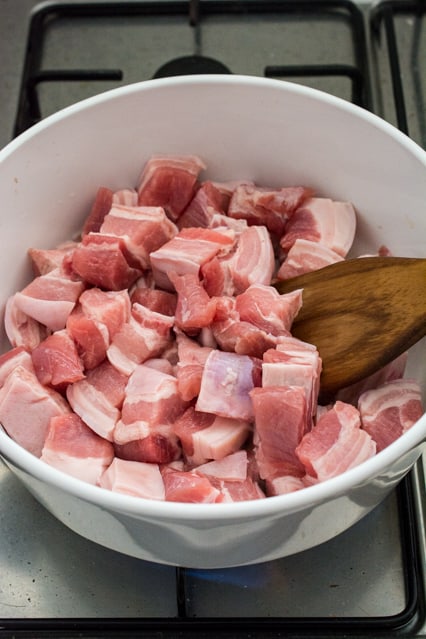
Toss in 5 peeled garlic cloves, 5 bay leaves, and 1 tablespoon of whole peppercorns. Stir them in with the pork.
Would you like to save this?
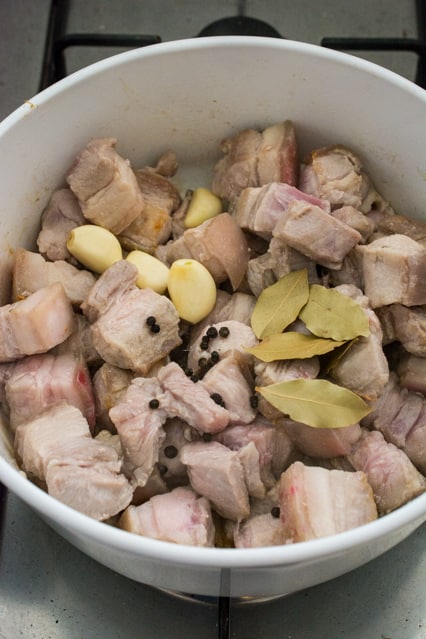
Pour the sauce over the pork.
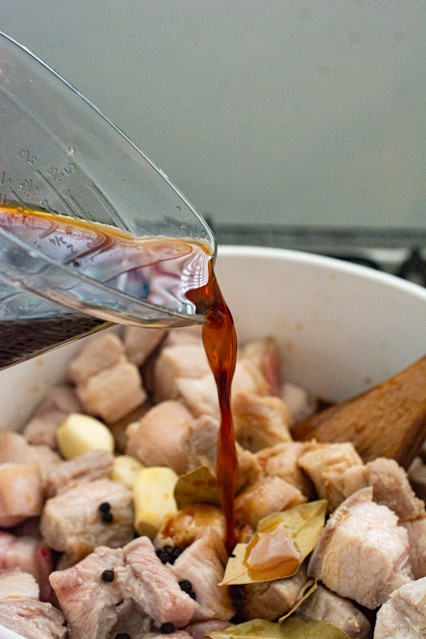
Then add 3 tablespoons of sugar. Give everything a good stir.

Bring the mixture to a boil over high heat, then let it simmer (while stirring ocassionally) on a low heat, partially uncovered.

Simmer the pork for approximately 45 minutes to an hour, or until the liquid is reduced by half and the pork is tender. If the liquid reduces too quickly, add a bit more water to keep the meat braising and prevent it from drying out.
Serve your Pork Belly Adobo over steamed white rice. Enjoy!
Frequently Asked Questions
Absolutely! Pork shoulder is a great alternative to pork belly, offering a slightly leaner option while still staying tender.
Traditional Filipino Adobo is made with cane vinegar. If you can't find cane vinegar, white vinegar is the best substitute. You can also try apple cider vinegar or rice vinegar, but keep in mind it will alter the taste.
Pork Adobo keeps well in the fridge for up to 4 days, and many say it tastes even better the next day! Store it in an airtight container and reheat in the microwave or stovetop.
Yes! Pork Adobo can be frozen for up to 3 months. Just thaw it in the fridge overnight, then reheat on the stovetop or in the microwave when you're ready to enjoy it.
If you’re looking to reduce the saltiness, try using low-sodium soy sauce. It’s a great option if you're watching your salt intake or find the regular version too strong for your taste.
Absolutely! The cooking process is quite similar. Instead of cooking the pork in a pot, sear the pork in your Instant Pot using the Saute feature. After the pork has browned, add garlic, bay leaves, peppercorns, followed by the sauce and sugar. Secure the lid, then Pressure Cook on High pressure for 15 minutes. After cooking, allow the pressure to release naturally for about 10 minutes, then do a quick-release for any remaining pressure.
The sauce will be thinner using this cooking method. To thicken the sauce, you can switch the Instant Pot back to Saute mode then let the liquid reduce for about 10 more minutes. Don’t forget the steamed rice to soak up all that delicious sauce!

Jumped straight here to the recipe? Please consider coming back to read the whole post when you have the time as I have included step-by-step instructions with photos.

Pork Adobo
Ingredients
- 2 lbs pork belly cut into cubes
- 2 teaspoons salt
- 3 tablespoons cooking oil
- 5 cloves garlic peeled
- 5 bay leaves
- 1 tablespoon whole black peppercorns
For the Adobo Sauce
- 2 cups water
- ¼ cup soy sauce
- ¼ cup white vinegar
- 1 tablespoon dark soy sauce
- 3 tablespoons sugar
Instructions
- Sprinkle the salt over the pork, and gently "massage" it into the meat. Allow the pork to marinate for 30 minutes.
- While the pork is marinating, prepare the sauce by combining the water, soy sauce, dark soy sauce and white vinegar in a bowl or measuring cup
- Heat the cooking oil in a large dutch oven or pot over medium-high heat.
- Add the pork belly and sear it just until the outside turns golden brown; no need to cook it all the way through at this point.
- Toss in the garlic cloves, bay leaves and whole peppercorns. Stir them in with the pork
- Pour the sauce mixture over the pork, followed by the sugar. Give everything a good stir.
- Bring the mixture to a boil over high heat, then let it simmer (while stirring occasionally) on a low heat, partially uncovered.
- Simmer the pork for approximately 45 minutes to an hour, or until the liquid is reduced by half and the pork is tender. If the liquid reduces too quickly, add a bit more water to keep the meat braising and prevent it from drying out.
- Enjoy with steamed rice!
Nutrition
Other Pork Recipes You May Enjoy
Soy Sauce Braised Pork Belly (Tau Eu Bak)
Vietnamese Lemongrass Pork Bahn Mi Burger
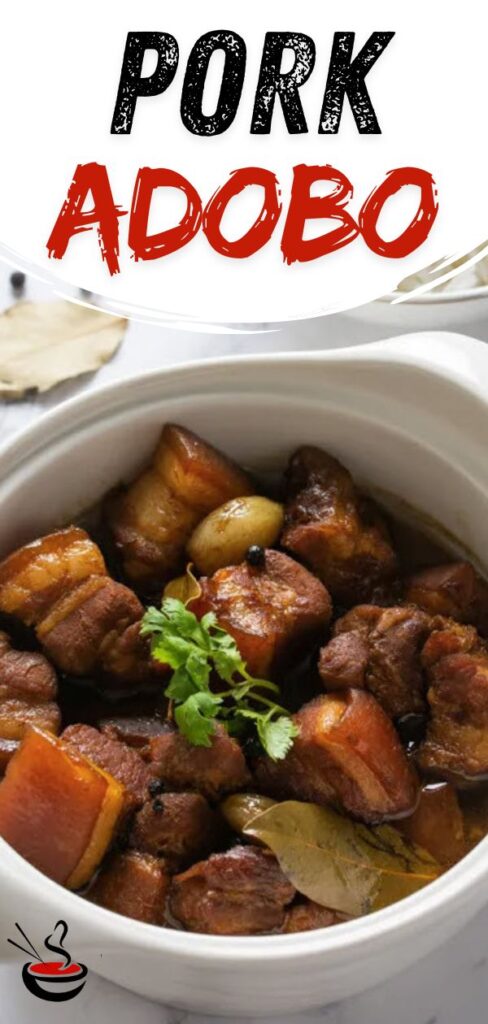



Leave a Reply